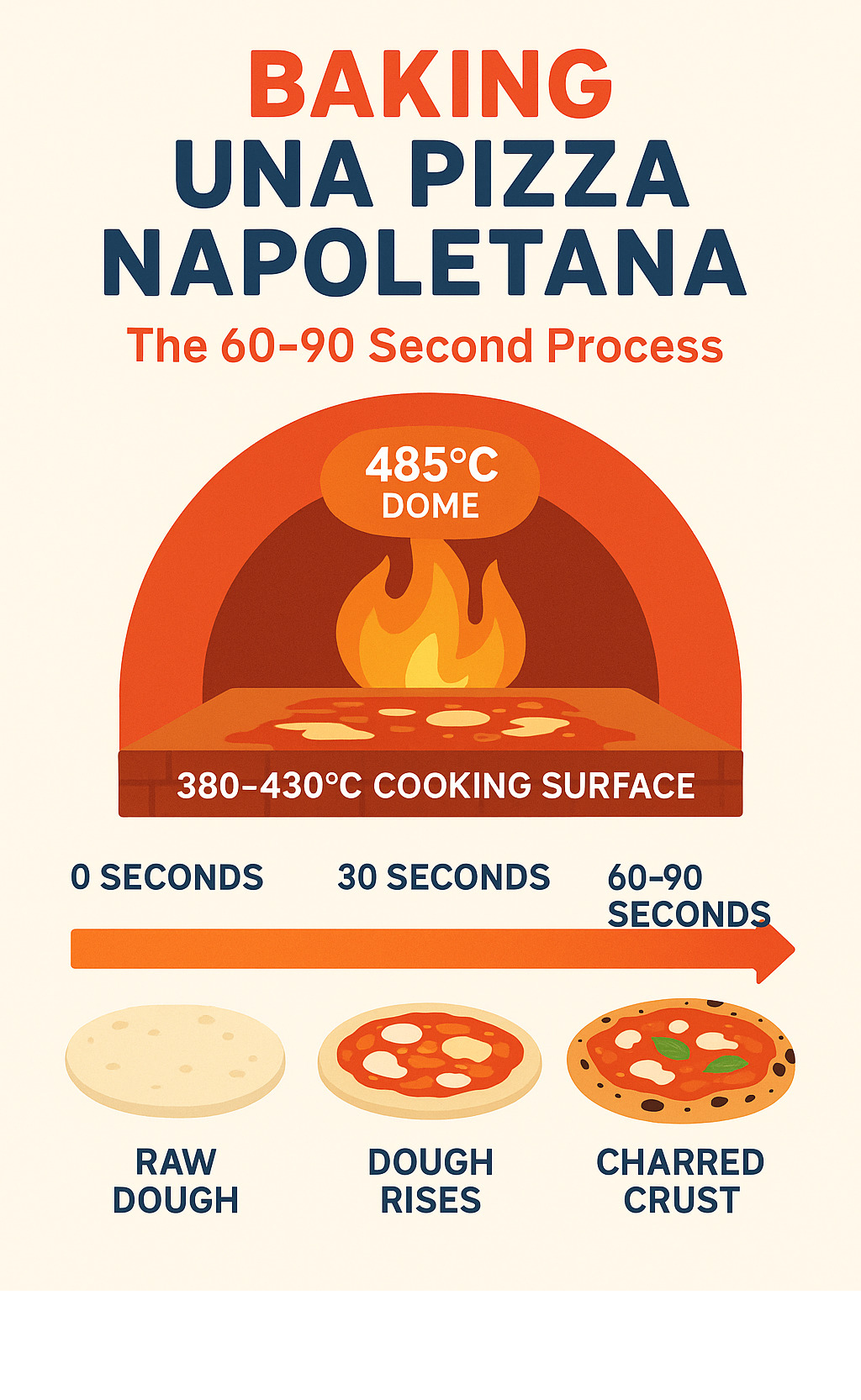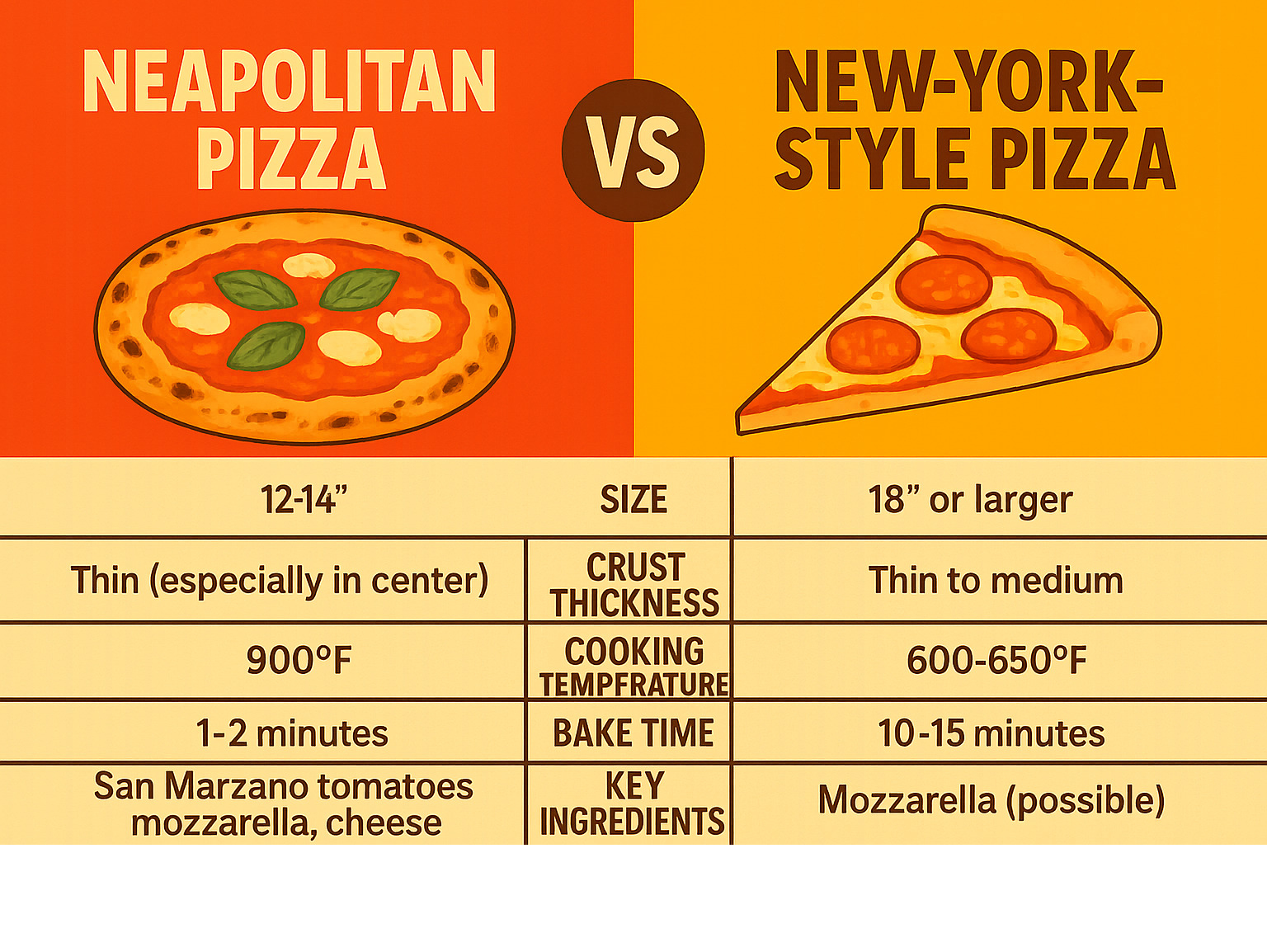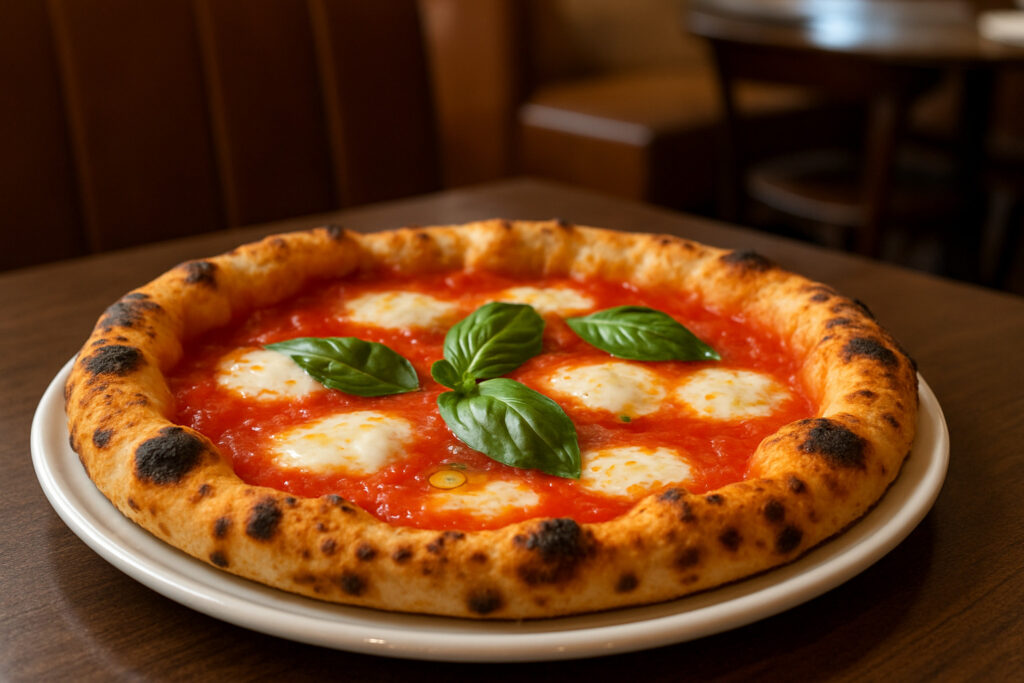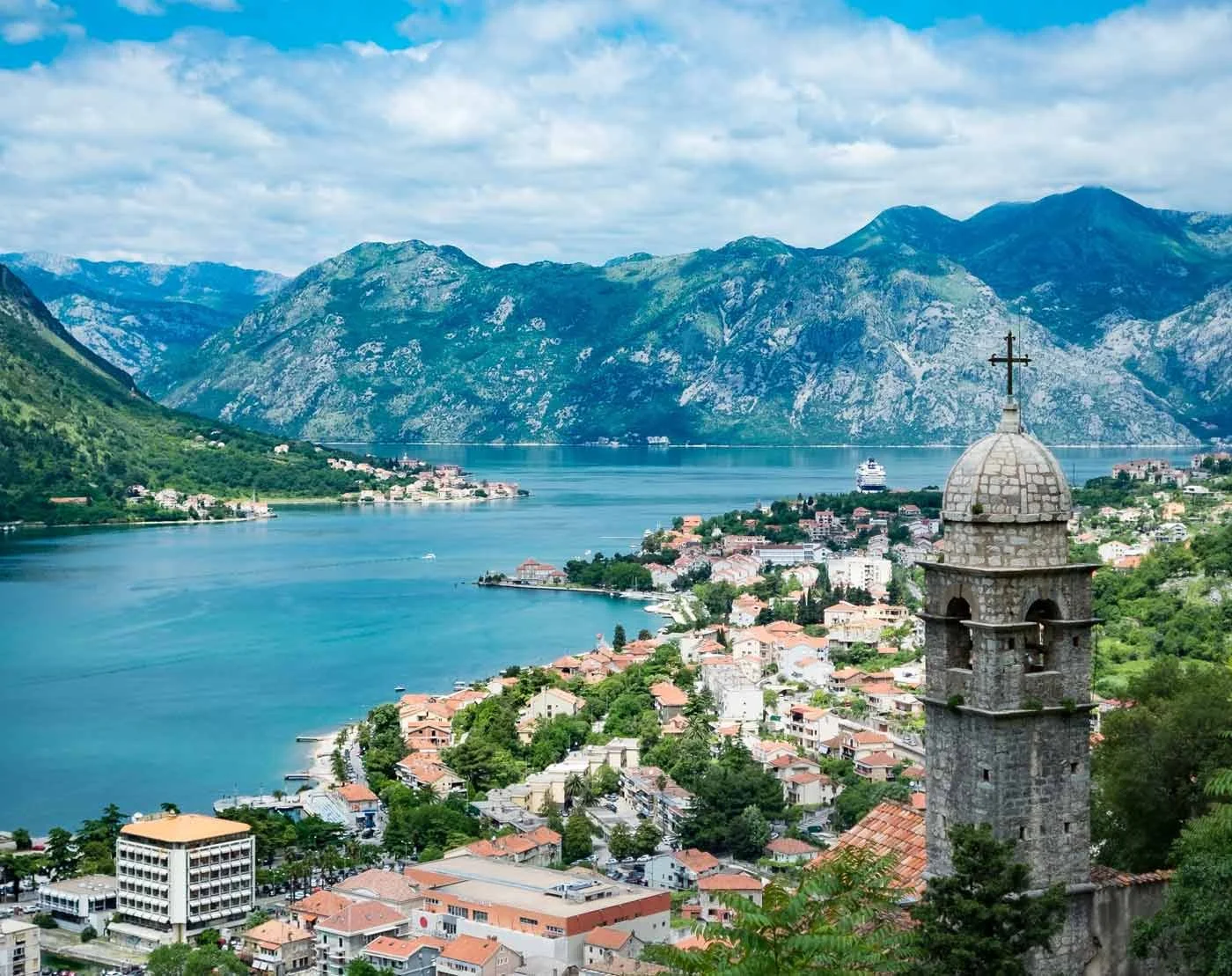Why Una Pizza Napoletana Represents the Gold Standard of Authentic Pizza
Una pizza napoletana isn’t just pizza – it’s a UNESCO-protected culinary art form that has captivated food lovers worldwide with its perfect simplicity. This authentic Neapolitan pizza features a soft, thin center surrounded by puffy, charred edges, made from just four ingredients and baked in a blazing wood-fired oven for 60-90 seconds.
Quick Facts About Una Pizza Napoletana:
- Origin: Naples, Italy (18th century)
- UNESCO Status: Intangible Cultural Heritage (2017)
- Cooking Method: Wood-fired oven at 485°C (905°F)
- Bake Time: 60-90 seconds only
- Classic Varieties: Margherita and Marinara
- Key Ingredients: Tipo 00 flour, San Marzano tomatoes, mozzarella di bufala, fresh basil
- Size Limit: Maximum 35cm diameter with 1-2cm raised crust
The magic happens in those blazing ovens where skilled pizzaiuoli craft each pie by hand. No rolling pins, no mechanical presses – just centuries-old techniques passed down through generations of Neapolitan masters.
What makes this pizza special isn’t complexity, but restraint. The dough contains no fats or sugars. The toppings are minimal. Yet when that perfectly fermented dough hits the wood-fired heat, it transforms into something extraordinary – soft and elastic with a fragrant, leopard-spotted crust.
From Naples street vendors to high-end restaurants worldwide, una pizza napoletana has become the benchmark for authentic pizza. Whether you’re planning a food pilgrimage to Italy or seeking the real deal in your hometown, understanding what makes Neapolitan pizza authentic will lift every bite.

Simple * una pizza napoletana* glossary:
The Legacy of Neapolitan Pizza: Origins & UNESCO Recognition
Picture this: it’s 1700s Naples, and the air is thick with the aroma of wood smoke and baking dough. Street vendors are calling out to hungry workers, selling simple flatbreads topped with tomatoes, oil, and garlic. What they didn’t know was that they were creating culinary history – what we now celebrate as una pizza napoletana.
The change from street food to cultural icon happened gradually, then suddenly. When King Ferdinando of Bourbon shocked his court by actually visiting pizzerias in Naples, he wasn’t just breaking royal protocol – he was elevating an entire food culture. Imagine the scandal! A king eating with his hands alongside common folk.
But the real game-changer came in 1889 with Queen Margherita of Savoy. The famous pizzaiolo Raffaele Esposito created what we now call Pizza Margherita specifically for her visit. The red tomatoes, white mozzarella, and green basil weren’t just delicious – they perfectly matched the Italian flag. Sometimes the best marketing happens by accident.
Fast-forward to 2017, and una pizza napoletana achieved something remarkable: UNESCO recognition as an Intangible Cultural Heritage. This wasn’t just about the pizza itself, but about honoring the entire craft of the pizzaiuolo – those skilled artisans who turn simple ingredients into edible art.
Scientific research on cultural heritage shows how traditional food practices like pizza-making carry deep cultural significance that goes far beyond taste. When you’re planning your own pizza pilgrimage, our guide to Hidden Gems to Visit in Italy in Summer can help you find authentic experiences beyond the tourist trail.
History of una pizza napoletana
Before there was una pizza napoletana, there was mastunicola – the humble ancestor that appeared around 1600. This early flatbread was topped with lard, cheese, and basil, but something was missing. Tomatoes were still sitting pretty in Spanish gardens as decorative plants, completely unaware of their pizza destiny.
The breakthrough came in the late 17th century when tomatoes finally made their way into Neapolitan kitchens. The combination of tomato, oil, and garlic created Pizza Marinara – named after the fishermen who grabbed these portable breakfasts before heading out to sea at dawn.
Street vendors became the heroes of this story, selling these delicious creations folded in paper. The “pizza a portafoglio” (wallet pizza) was born out of necessity – how else do you eat pizza while walking through busy Naples streets?
This tradition proved so enduring that even President Clinton couldn’t resist trying a folded pizza during the 1994 G7 summit in Naples. When world leaders start eating your street food, you know you’ve made it.
Why UNESCO Protects una pizza napoletana
UNESCO’s protection goes much deeper than preserving a recipe – it’s about safeguarding intangible skills that can’t be learned from YouTube videos. The pizzaiuolo’s craft involves reading dough fermentation by touch, shaping the perfect cornicione by hand, and understanding the temperamental moods of a wood-fired oven.
These skills pass from master to apprentice through years of practice and cultural immersion. You can’t download this knowledge – it lives in the hands and hearts of Naples’ pizza makers.
But here’s what makes una pizza napoletana truly special: it’s a social ritual that brings communities together. In Naples, sharing pizza isn’t just about satisfying hunger – it’s about conversation, connection, and maintaining the cultural threads that weave through generations.
This community pride and social bonding is exactly why UNESCO stepped in to protect not just the food, but the entire cultural practice surrounding it. When you bite into an authentic Neapolitan pizza, you’re tasting centuries of tradition and community spirit.
What Makes una pizza napoletana Authentic?
When it comes to una pizza napoletana, authenticity isn’t a matter of opinion – it’s carefully regulated science. The Associazione Verace Pizza Napoletana (AVPN) and the European Union’s Traditional Speciality Guaranteed (STG) certification have created strict standards that protect this culinary treasure from imitation.
These regulations might seem obsessive, but they preserve something magical. Your pizza napoletana must measure no more than 35 centimeters across, with the center staying incredibly thin at just 0.3 centimeters thick. The famous puffy edge – called the cornicione – can only rise between 1-2 centimeters high. Any bigger or smaller, and it’s not authentic.
The dough recipe is beautifully simple yet unforgiving. Only Tipo 00 flour (with up to 20% Tipo 0 allowed), water, salt, and yeast can touch that bowl. No oils, no sugars, no shortcuts. This purity creates the distinctive soft texture that makes Neapolitan pizza so different from its American cousins.
San Marzano tomatoes are the gold standard for the sauce, prized for their natural sweetness and perfect acidity balance. The cheese must be either creamy mozzarella di bufala campana or the delicate fior di latte di Agerola. Fresh basil leaves and a drizzle of extra virgin olive oil complete the classic Margherita, while the traditional Marinara skips the cheese for garlic and oregano instead.
Scientific research on AVPN standards shows just how detailed these requirements get – right down to the specific varieties of tomatoes and the mineral content of the water used.

The cooking method is where the real magic happens. That wood-fired oven must reach a scorching 485°C (905°F), and your pizza gets just 60-90 seconds inside. This intense blast creates those beautiful leopard spots on the crust while keeping the center wonderfully soft and slightly wet – a texture that might seem undercooked to newcomers but is absolutely perfect for authentic Neapolitan style.
More info about Innovative Restaurant Concepts explores how these traditional techniques continue to inspire modern dining experiences around the world.
Serving una pizza napoletana Like a Local
Eating una pizza napoletana properly is half the fun, and Neapolitans have their techniques down to an art. You’ll often see locals folding their pizza “a libretto” – like closing a book – which makes the soft, floppy crust much easier to handle. Don’t worry about looking touristy; this fold is pure practicality born from generations of pizza eating.
The knife-and-fork approach works beautifully too, especially for tackling that molten center where the cheese and sauce create a delicious mess. There’s no wrong way, but there is one crucial rule that every pizzaiolo will tell you.
The eat-fresh rule isn’t negotiable. The AVPN actually forbids freezing, deep-freezing, or vacuum-packing authentic Neapolitan pizza because it must be devoured straight from the oven. This isn’t just tradition being stubborn – it’s about preserving that perfect moment when the crispy-chewy crust, bubbling cheese, and bright tomato sauce create pure harmony.
Wait even ten minutes, and you’ve missed the magic that makes una pizza napoletana so special. The textures change, the temperatures settle, and what was once perfection becomes just really good pizza. In Naples, they understand that some experiences can’t be saved for later.
Crafting Una Pizza Napoletana: Dough to Oven
The journey from flour to finished pizza is a masterclass in patience and precision. We’re constantly amazed by how four simple ingredients – Tipo 00 flour, water, salt, and yeast – can create something so extraordinary when handled with skill and respect.
The dough hydration must be between 55-62%, creating a soft, extensible texture that can be stretched paper-thin without tearing. The fermentation process is crucial: a minimum of 8 hours and up to 24 hours allows the dough to develop complex flavors and the perfect texture for that characteristic cornicione.
Each dough ball weighs between 200-280 grams, precisely portioned to create the standard 22-35 cm pizza. The “staglio” technique – borrowed from mozzarella-making – creates perfectly round portions that ferment evenly.
The wood-fired oven is the heart of authentic Neapolitan pizza. These dome-shaped ovens, traditionally built with specific proportions, create a unique cooking environment. The dome reaches 485°C while the cooking surface maintains 380-430°C, creating the perfect conditions for that lightning-fast 60-90 second bake.
More info about Best Unique Restaurants showcases establishments that honor traditional techniques while creating memorable dining experiences.
Dough Preparation & Fermentation
The mixing order matters more than most people realize. Water, flour, salt, and yeast must be combined in a specific sequence, with salt and yeast never in direct contact for more than five minutes to prevent the salt from killing the yeast.
The fermentation happens in two stages: first, a bulk rise of about 2 hours at room temperature, then individual dough balls are placed in boxes for 4-6 hours of controlled fermentation at 18-20°C with 60-70% humidity. This double fermentation develops the gluten structure while creating the complex flavors that make Neapolitan pizza special.
Temperature control is critical throughout the process. The dough must stay cool during mixing to prevent overheating, and the fermentation environment must be carefully monitored. Professional pizzerias invest in specialized fermentation rooms, but the principles remain the same whether you’re making one pizza or a hundred.
Shaping & Topping the Pie
Shaping una pizza napoletana is where artistry meets technique. The pizzaiolo starts from the center, gently pushing outward while preserving the precious alveoli (air bubbles) that create the signature cornicione. No rolling pins allowed – only hands can maintain the delicate gas structure.
The topping application follows a precise pattern. Tomato sauce is applied in a spiral motion from the center outward, leaving the edges clean for the cornicione to rise. Cheese is distributed evenly but sparingly – too much will make the pizza soggy. Fresh basil and olive oil are added last, often after baking to preserve their bright flavors.
The entire process from shaping to oven entry should take no more than a few minutes. Any longer, and the dough begins to lose its structure and become difficult to handle.
Where to Taste Authentic Neapolitan Pizza Worldwide
Nothing quite compares to savoring una pizza napoletana in its birthplace of Naples, where every corner pizzeria seems to guard centuries-old secrets. But here’s the wonderful news for pizza lovers everywhere – authentic Neapolitan pizzerias have spread across the globe, bringing that magical 90-second wood-fired experience to your doorstep.
The secret to finding genuine una pizza napoletana outside Italy lies in understanding what to look for. AVPN certification is your golden ticket – it means the pizzeria has met the strict standards we discussed earlier. Even better are pizzaioli who’ve actually trained in Naples, absorbing not just the techniques but the passionate culture that makes this pizza special.
Anthony Mangieri’s journey perfectly illustrates this dedication to authenticity. His Una Pizza Napoletana in New York City represents the hardcore approach – he regularly makes pilgrimages to Naples to refine his craft and famously closes shop when the day’s dough runs out. This isn’t a business strategy; it’s pure respect for the tradition that refuses to compromise quality for quantity.

Calgary and Edmonton pizza lovers have finded their own slice of Naples through UNA pizza locations, where traditional wood-fired techniques meet Canadian hospitality. These spots prove that authentic una pizza napoletana can thrive anywhere when the commitment to traditional ingredients and methods remains unwavering.
What makes these international outposts truly special goes beyond perfect dough and San Marzano tomatoes. The best ones capture the communal spirit of Neapolitan pizza culture – that theatrical preparation where pizzaioli spin dough with practiced flair, the immediate consumption that turns dining into a shared moment, and the convivial atmosphere that makes every meal feel like a celebration.
More info about Best Food Destinations can help you plan culinary trips around the world’s most authentic pizza destinations.
When hunting for genuine una pizza napoletana in your travels, trust your instincts along with these telltale signs. Wood-fired ovens should dominate the space with their characteristic dome shape. Lightning-fast bake times of 60-90 seconds mean you’ll watch your pizza transform before your eyes. Minimal toppings that let each ingredient shine, and most importantly, passionate pizzaioli who can share stories about their training and explain why they source specific ingredients.
The best authentic pizzerias often have one delightful frustration in common – they run out of dough or have waiting lists. Rather than seeing this as inconvenience, accept it as proof that you’ve found somewhere that prioritizes the integrity of the craft over churning out endless pies. After all, true una pizza napoletana is worth the wait.
Frequently Asked Questions about una pizza napoletana
What ingredients are absolutely non-negotiable?
When it comes to authentic una pizza napoletana, there’s no room for substitutions on the core ingredients. The dough must contain only Tipo 00 flour (with up to 20% Tipo 0 allowed), water, salt, and yeast – absolutely no fats, sugars, or additives that you might find in other pizza styles.
For toppings, San Marzano tomatoes are the gold standard for sauce. These aren’t just fancy marketing – their naturally sweet flavor and low acidity create the perfect base that won’t overpower the delicate dough. The cheese must be either mozzarella di bufala campana or fior di latte di Agerola, both protected designations that guarantee specific quality and flavor profiles.
The classic Margherita gets finished with fresh basil and extra virgin olive oil, while the Marinara uses garlic and oregano instead of cheese. These might seem like simple ingredients, but their quality makes all the difference between good pizza and transcendent pizza.
We’ve tasted pizzas made with regular grocery store mozzarella versus true buffalo mozzarella from Campania, and the difference is remarkable. The buffalo version has a creamier texture and more complex flavor that lifts the entire pizza experience.
Can I recreate the 90-second bake in a home oven?
Here’s the honest truth: your home oven simply can’t reach the 485°C (905°F) required for authentic una pizza napoletana. Most home ovens max out around 260°C, which is less than half the temperature needed for that lightning-fast bake that creates the signature leopard-spotted crust.
The intense heat isn’t just about speed – it’s about creating a specific texture where the outside chars and bubbles while the center stays soft and slightly wet. Without that extreme temperature, you’ll get pizza, but it won’t have the authentic Neapolitan character.
That said, you can get much closer to the real thing with some investment. A pizza stone or steel preheated to your oven’s maximum temperature will help. Some dedicated home cooks install outdoor wood-fired ovens or specialized countertop pizza ovens that reach higher temperatures.
While these won’t quite match a professional Neapolitan oven, they can produce excellent results that capture much of what makes una pizza napoletana special. The key is getting as hot as possible and working quickly.
What’s the difference between AVPN and STG certifications?
Both certifications protect authentic una pizza napoletana, but they work in different ways. The Associazione Verace Pizza Napoletana (AVPN) is a private organization founded in 1984 that promotes traditional Neapolitan pizza through voluntary certification. When you see their logo at a pizzeria, it means they’ve met strict standards for ingredients, preparation, and cooking methods.
STG (Traditional Speciality Guaranteed) is the heavyweight champion of pizza protection. This official European Union designation legally protects the name “Pizza Napoletana” and defines exactly how it must be made. Think of it like Champagne – only sparkling wine from the Champagne region can use that name, and only pizza meeting STG standards can be called “Pizza Napoletana STG.”
The practical difference? AVPN certification relies on industry recognition and consumer awareness to maintain standards. STG has actual legal backing – it’s illegal in the EU to call something “Pizza Napoletana STG” unless it meets the official requirements.
Both serve the same noble goal of preserving this incredible culinary tradition, ensuring that when you order una pizza napoletana, you’re getting the real deal that’s been perfected over centuries in Naples.
Conclusion
The journey through una pizza napoletana reveals something beautiful about food culture – how a simple combination of flour, water, salt, and yeast can carry the weight of centuries and connect people across continents. This isn’t just pizza we’re talking about; it’s a living piece of history that continues to evolve while honoring its roots.
What strikes us most about Neapolitan pizza is how it teaches us to value authenticity in an age of shortcuts. The 90-second bake time, the hand-stretched dough, the insistence on specific ingredients – these aren’t arbitrary rules but time-tested principles that create something truly special.
At The Dining Destination, we’ve seen how understanding the story behind una pizza napoletana transforms the dining experience. When you know about the UNESCO protection, the generations of pizzaioli who perfected their craft, and the cultural significance of sharing pizza in Naples, every bite becomes more meaningful.
The global spread of authentic Neapolitan pizzerias shows us something hopeful about food culture. Despite globalization’s tendency to homogenize flavors, passionate chefs and food lovers continue to seek out and preserve traditional techniques. Whether it’s a tiny pizzeria in Naples or a certified AVPN restaurant in New York, the commitment to authenticity keeps these traditions alive.
Planning your own pizza pilgrimage? The beauty of una pizza napoletana is that it rewards the curious traveler. Naples remains the ultimate destination, but authentic experiences await in unexpected places worldwide. Look for those wood-fired ovens, listen for the stories behind the dough, and prepare to be amazed by what skilled hands can create.
More info about best food travel destinations can help you plan your next culinary journey to experience authentic Neapolitan pizza and other traditional foods around the world.
The next time you watch a pizzaiolo stretch dough with theatrical flair or see those characteristic leopard spots on a perfectly baked crust, you’ll understand you’re witnessing something special. Una pizza napoletana reminds us that the best things in life often come from respecting tradition, using quality ingredients, and taking the time to do things right.








